
A Busy Week in Europe and Earnings Reports
This past week has been eventful, with geopolitical tensions intensifying, shifting expectations on the Federal Reserve’s potential moves, rate cuts from key global economies, and the start of a strong earnings season.
Looking week ahead, geopolitical tensions show no signs of easing, but market participants will shift their attention to U.S. earnings reports and the upcoming European Central Bank (ECB) meeting. Meanwhile, China’s recent stimulus package has captured attention, yet further details are needed to assess its full impact on the global economy. The combination of these events will drive market sentiment in the week ahead.
USA and Wall Street: Inflation Challenges Amid Resilient Labor Market
After robust labor market data in the first week of October, more recent figures confirmed that the Federal Reserve will face increasing challenges in controlling inflation. September’s headline inflation rose by 0.2%, repeating August’s pace, driven mainly by higher grocery prices, while gasoline costs fell. This led headline inflation to ease to 2.4% year-over-year (YoY), but Core CPI increased to 3.3% YoY, slightly up from August’s 3.2% reading. Core goods prices reversed a six-month decline with widespread increases in categories like vehicles, apparel, and household furnishings.
Although the Producer Price Index (PPI) for September showed a smaller-than-expected drop, there are signs inflation could continue to trend lower in the months ahead, albeit slowly and with further challenges.
Additionally, the latest NFIB survey indicated a slight improvement in small business optimism for September, though overall sentiment remains subdued in the current economic environment. As for labor data, while initial jobless claims were higher than expected, the numbers have been influenced by temporary factors like recent storms, making them unreliable as a reference for the next two to three weeks.
Based on the data, we anticipate that the Federal Reserve will likely ease its policy more gradually, with the possibility of one or two rate cuts of 25 basis points at its two remaining meetings this year (Nov. 7 and Dec. 18).
As we head into the new week, several key factors will shape the financial landscape. Firstly, the full economic impact of Hurricane Milton in Florida is yet to be seen. Meanwhile, the US Presidential election is heating up, with just 23 days left and the race between the two candidates remaining extremely close. In this uncertain environment, the economic calendar is less busy, but market participants will be watching geopolitical tensions, earnings reports, and comments from Fed speakers for further direction.
Key Economic Data & Fed Watch: While the focus remains on geopolitical risks and earnings, the release of US economic data—such as Retail Sales and Industrial Production on Thursday, and Housing Starts on Friday—will also attract attention. Fed speakers throughout the week are expected to adopt a more cautious tone, likely offering unclear or non-committal answers to key questions about future monetary policy, especially as inflation remains a concern.
- Retail Sales: After the upside surprise in August (0.2% rise vs. expectations of a 0.1% decline), we expect retail sales to continue growing moderately, forecasting a 0.3% monthly rise for September and an uptick in annual growth from August’s 2.13%.
- Industrial Production: In line with retail sales, we anticipate industrial production to show positive momentum as stronger demand and lower rates support both industrial and manufacturing outputs.
- Housing Starts: With signs of a positive outlook for residential construction, we foresee housing starts at 1.360M units, slightly up from the 1.356M pace in August, bolstered by improved builder sentiment, as inflation and interest rate expectations become more favorable.
These data points are expected to support the Fed’s gradual rate cut process, which will likely proceed slowly. While this outlook may not be immediately favorable for stock markets, it should provide strength for the US dollar, helping it maintain recent gains.
Technical Outlook: S&P 500 and DXY
S&P 500: The recent uptrend in the S&P 500 seems to be losing momentum, especially after reaching new all-time highs. The index may be ready to give back some of its gains. Key support levels to watch are 5,750, with further downside targets at 5,680 and 5,615 if the 5,750 level breaks.
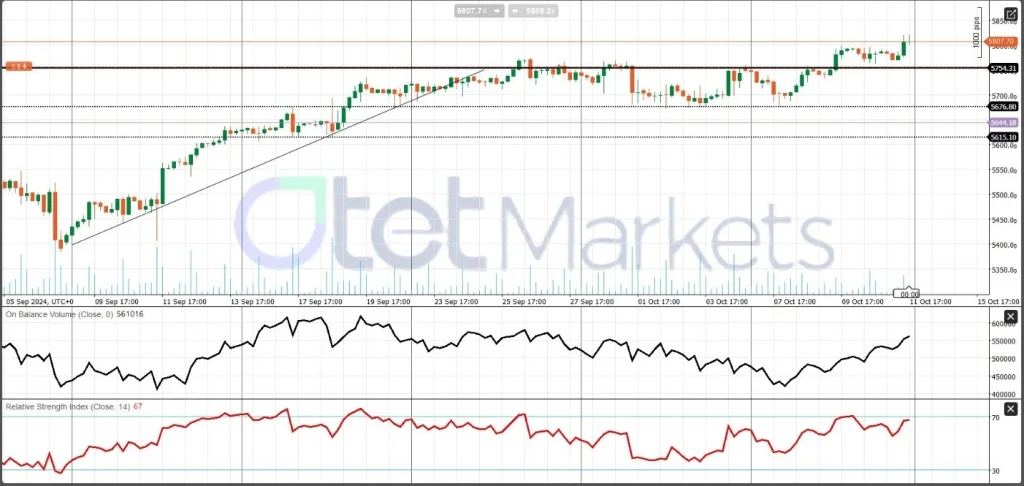
DXY (US Dollar Index): The DXY remains bullish, particularly while trading above the 102 level. The immediate upside target is 103.45. However, a break below the 102 mark could shift market sentiment, signaling a potential reversal in the dollar’s recent strength.
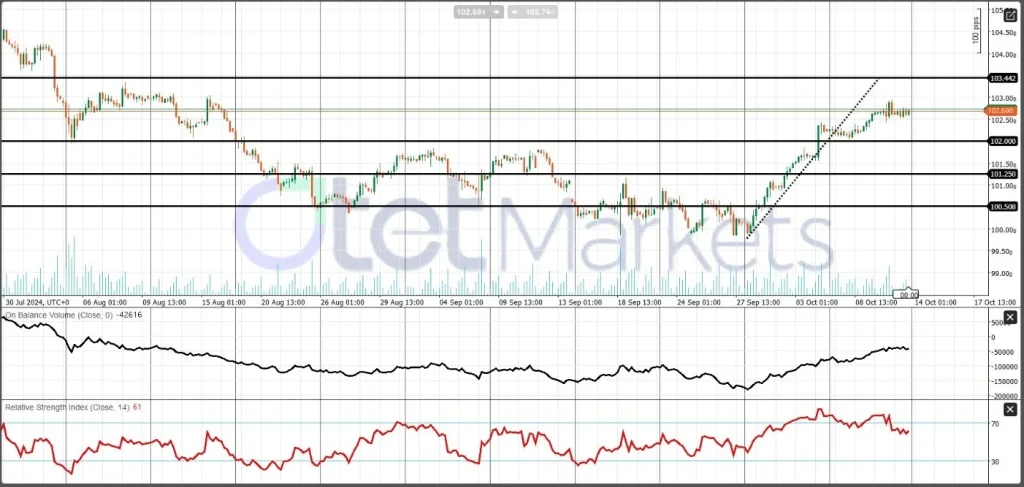
In summary, while the US economy faces inflation challenges and geopolitical risks, expectations of moderate economic growth and Fed rate cuts will keep markets on edge. Investors will need to navigate earnings reports, data releases, and geopolitical developments to gauge the broader economic outlook for the final quarter of 2024.
EU and ECB: A Tough Week Ahead
The Eurozone is facing a challenging week with key economic data releases and the highly anticipated European Central Bank (ECB) interest rate decision taking center stage. The ECB’s recent rate hikes have been successful in curbing inflation, but they have also had a disruptive effect on economic growth in the region.
Signs of Economic Weakness
Recent data confirms the growing concerns about the Eurozone’s slowing economy:
- Manufacturing PMI dropped to 45.0 in September, while the previously resilient Services PMI has also weakened in recent months.
- Additional indicators such as the Eurozone Business and Consumer Survey (96.2, below estimates) and the Business Climate (-0.72) point to ongoing struggles.
Sentiment Data:
- Services Sentiment improved to 6.7, slightly beating forecasts, but Industrial Confidence worsened further to -10.9.
- Consumer confidence held steady at -12.9, but overall business confidence in the region is fragile.
These figures suggest that the Eurozone may be heading for a weak Q4, raising concerns about GDP growth for the remainder of 2024. Despite these challenges, inflation data has been encouraging. Headline CPI inflation eased to 1.8% in September—falling below the ECB’s 2% target for the first time since 2021. Core inflation also edged down to 2.7% from 2.8%.
ECB Decision: What to Expect
Initially, the chances of a rate cut in October seemed slim, but recent data has shifted expectations. Now, we expect a 25 bps rate cut during the ECB meeting on Thursday, October 17th. While this decision may be well-received by European stock markets, it’s unlikely to be favorable for the Euro.
Technical Outlook for EUR/USD
The technical outlook for EUR/USD remains bearish despite a short-term recovery. The pair is facing strong resistance at 1.10. As long as it trades below this level, the first support and target is 1.08 in the near term.

Gold Grows Despite Hotter CPI and Rising USD
Gold prices bounced back on Thursday after a brief correction, reversing four consecutive bearish trading sessions, even as the US dollar (USD) strengthened following a hotter-than-expected Consumer Price Index (CPI) report for September. Despite the USD rally, ongoing tensions in the Middle East continued to underpin demand for gold, a key safe-haven asset.
The September CPI and recent labor market figures exceeded expectations, solidifying market sentiment that the Federal Reserve (Fed) may maintain its hawkish stance. According to the CME FedWatch Tool, there is currently about an 85% chance that the Fed will reduce interest rates by 25 basis points at their November meeting, while the probability of holding rates steady is around 15%.
These Fed expectations point to higher yields, which could limit the upside potential for stock markets. At the same time, it’s earnings season, and many investors are either selling off or adjusting their portfolios, creating volatility. Combined with heightened political and geopolitical risks, these conditions have bolstered the appeal of gold as a safe-haven asset.
Technical Outlook for Gold
From a technical standpoint, holding the key support level of 2,640 USD could drive gold prices toward 2,670 USD. If momentum continues, gold may even challenge its all-time high of around 2,685 USD.
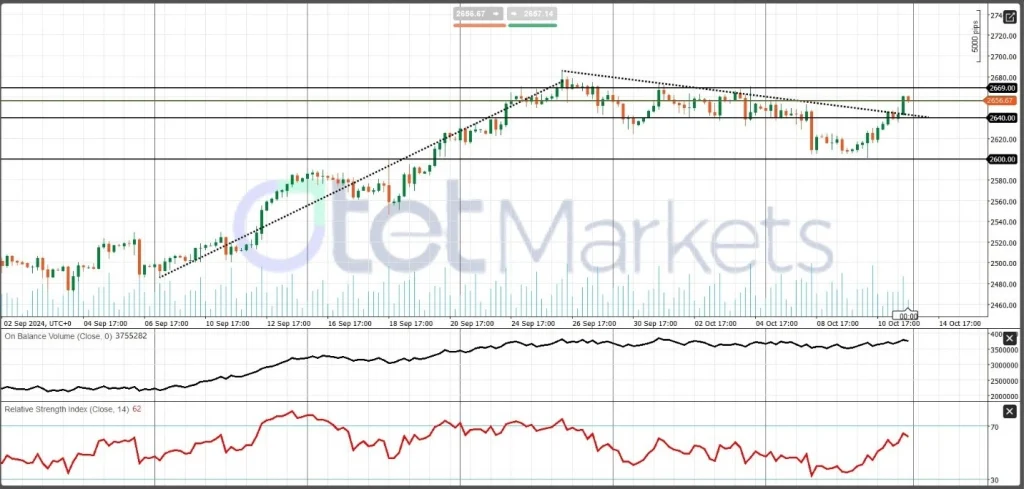
The combination of inflationary pressures, Fed rate expectations, and geopolitical risks creates a favorable environment for gold’s continued strength.
Oil: Politicians Decide the Prices!
These days, economic data on market demand or producer supplies seems to have taken a backseat, with geopolitical tensions playing a dominant role in determining oil prices. The escalating situation in the Middle East, particularly the potential actions of Israel against Iran, has investors bracing for a volatile market.
While the Biden Administration has urged Israel to exercise restraint and avoid targeting specific locations, such as refineries, Israeli Prime Minister Benjamin Netanyahu has referred to the situation as a “Historic Opportunity.” Reports suggest that both sides may have reached some form of agreement, potentially delaying any attacks on Iranian oil infrastructure until closer to the US elections, to avoid influencing the election results.
The potential for an attack on Iran’s oil infrastructure cannot be understated. A strike could push crude oil prices up by at least $10 per barrel. If Iran were to retaliate, for instance by targeting Saudi Arabia, oil prices could surge by $40 per barrel, pushing prices beyond $110 per barrel. The conflict between Israel and Iran has the potential to disrupt 30% of the world’s oil supply and key maritime routes, further intensifying the price spike.
On the economic data front, weak demand expectations make the long-term outlook for oil prices less optimistic. However, the upcoming reports from OPEC on Monday and the IEA on Tuesday could influence market sentiment by providing updates on market demand, supply dynamics, and the broader economic outlook.
Technical Analysis for Oil
From a technical perspective, $72 remains a key support level for oil prices. As long as prices hold above this level, there is potential for a rally toward $78, which seems like the next target. A short-term correction may precede this next bullish phase, making the market particularly volatile in the near term.
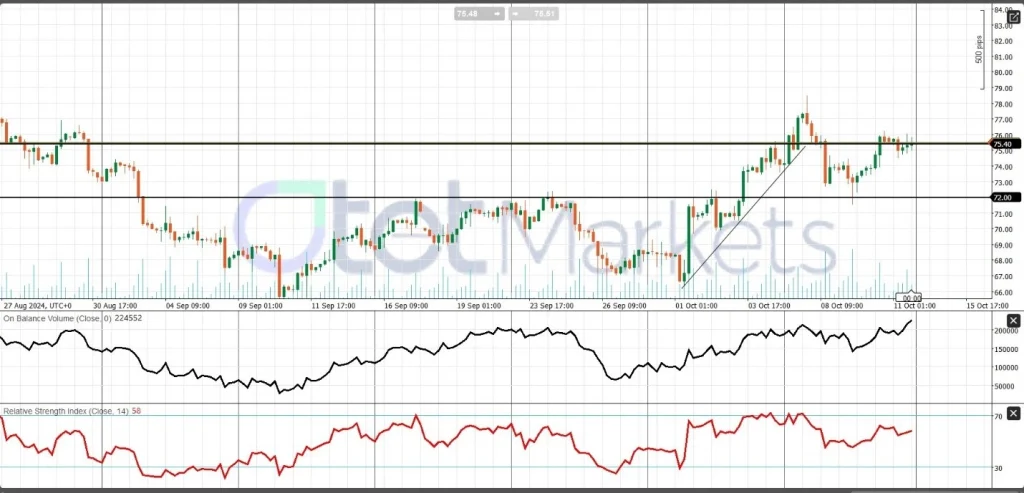
With geopolitical tensions simmering and economic reports on the horizon, the oil market is walking a fine line between potential surges and corrections.
BTC Holds $60K, but Doubts Persist!
Bitcoin briefly dipped below $60,000 last week on Thursday, but bulls quickly regained control, pushing the price back above this critical level. Since the beginning of August, BTC has been hovering around $60K, but it has struggled to firmly break above this key psychological threshold.
Technically, this behavior indicates a possible downward test of the $58,000 mid-line. Should this level fail to hold, a further decline toward the $55,000 support area could be expected. On the upside, a strong bullish trend is unlikely unless BTC successfully breaks above $66,000, which has acted as a key resistance zone in recent weeks.
Data from on-chain analytics firm Santiment reveals that major Bitcoin holders have sold or redistributed approximately 30,000 BTC (valued at over $1.8 billion). This selling pressure has added to the uncertainty in the market. Many short-term holders have also been liquidating their positions, but this transfer of coins to “stronger hands”—longer-term holders—could contribute to greater market stability in the long run.
In conjunction with other markets, it’s important to note that stock markets are also under pressure, and Bitcoin could experience a similar outlook due to the broader market sentiment. The volatility in equities may spill over into crypto, keeping the near-term outlook for BTC uncertain.
In summary, while $60K remains a crucial level for Bitcoin, the outlook appears uncertain without a sustained breakout above $66,000. At the same time, potential dips to $58K or $55K cannot be ruled out.

Share
Hot topics
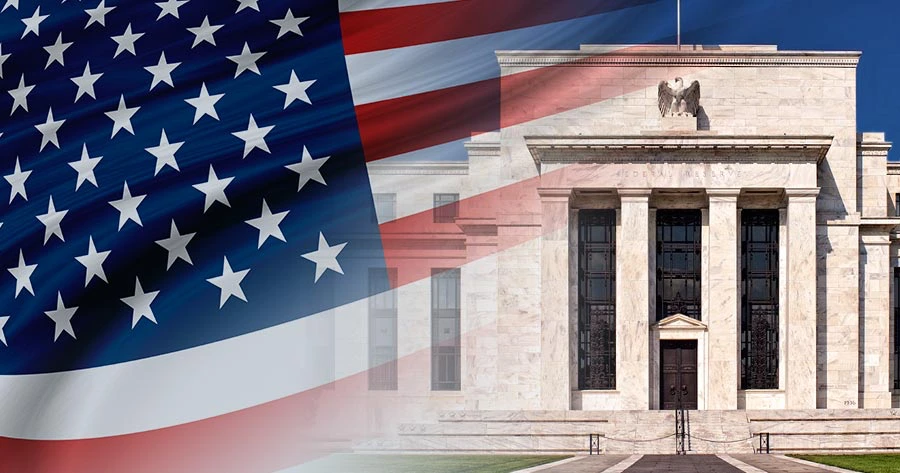
Federal Reserve’s Challenges to Trump’s New Policies
As the Federal Reserve Open Market Committee (FOMC) prepares for its upcoming meeting, all eyes are on how the Fed will respond to Donald Trump’s latest economic policies. With the...
Read more




Submit comment
Your email address will not be published. Required fields are marked *